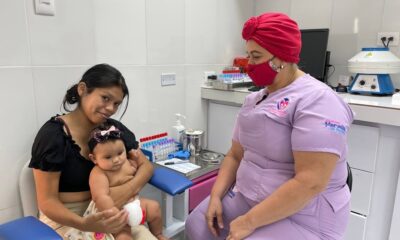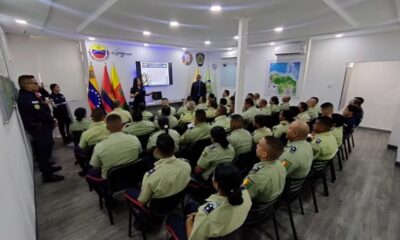Tecnología
¿Sabías qué en una olla arrocera se puede cocinar más que arroz?

La olla arrocera es unos de los electrodomésticos que no pueden faltar en tu cocina. Este aparato está diseñado para vaporizar o hervir perfectamente el arroz. Pero a pesar de lo que sugiere su nombre, se trata de un aparato muy versátil en el que se pueden cocinar varios alimentos.
Las diferentes recetas en olla arrocera que podemos preparar son una opción súper práctica para sacarle más provecho a este electrodoméstico y además para simplificar al momento de cocinar.
Hoy en día la tecnología nos ha llevado a optimizar muchas cosas y por supuesto la cocina no se queda atrás. Existen varios electrodomésticos que nos ayudan a hacer las cosas más rápido, como la olla arrocera y la variedad de recetas deliciosas que podemos preparar en ella.
Desde huevos, avena o pastel de chocolate son algunas de las deliciosas recetas que se pueden preparar en una olla arrocera.
Recetas en olla arrocera para tu día a día
Una arrocera eléctrica es un dispositivo que puede cumplir una doble función, no solo sirve para arroz, también se pueden hacer muchas otras cosas deliciosas, ganándose su lugar en cualquier cocina.
Preparar varias recetas de arroz
El trabajo principal de una olla arrocera es cocinar arroz. Hacer arroz en una olla arrocera es simple. Solo debes agregar agua y arroz al recipiente interior y enciéndelo. La magia de la olla arrocera se encargará del resto. Las ollas arroceras tienen un sensor que apaga automáticamente el calor cuando alcanza el punto adecuado.
Además, se puede preparar varias recetas de arroz, estas recetas incluyen una amplia variedad de ingredientes, desde carnes, verduras o mariscos, para satisfacer a todos los gustos, como un arroz con curry y pollo, arroz con camarones, arroz con pollo y verduras, arroz con leche, arroz con pollo y brócoli y más.
Granos
El arroz no es el único grano que puede manejar una olla arrocera, también puede cocinar otros como frijoles y lentejas. Cocinar granos en una olla arrocera es tan simple como hacer clic en un botón, mientras se puede dedicar su tiempo a otro tipo de preparaciones, como cocinar la proteína, ensaladas, vegetales o lo que sea para completar el menú.
Avena
El desayuno es la comida más importante del día, y en una olla arrocera se puede preparar una deliciosa avena para toda la familia de forma muy fácil y rápida. Además, cocinar avena en una olla arrocera es la manera perfecta de obtener un desayuno caliente sin tener que vigilar de cerca una olla de avena en la estufa.
Verduras
Las verduras son una excelente adición a cualquier comida y son tan fáciles de hacer con la arrocera que no tienes excusa para no añadirlas a tu menú del día.
Como puedes ver, puedes cocinar comidas completas en una olla arrocera, no solo arroz, atrévete a probar distintas preparaciones y sácale el máximo provecho a éste práctico electrodoméstico.
Quínoa
Más fácil de cocinar, imposible. Sólo tienes que poner 1 taza de quínoa y dos tazas de agua y encender la arrocera. Luego puedes comer la quínoa como más te provoque: como cereal en el desayuno, como ingrediente de ensalada, con vegetales salteados con salsa de soya. Las opciones de esta receta son infinitas.
Macarrones con queso
Esta rica y cremosa receta en olla arrocera se cocina en solo unos minutos y requiere sólo unos pocos ingredientes simples.
Coloca los macarrones, una taza de caldo de pollo y una pizca de sal en la olla arrocera por 15 minutos. Luego, agrega una taza de leche y una taza y media de queso rallado. Revuelve bien para mezclar y déjalo cocinar por 20 minutos más.
Pastel de chocolate fundido
En una olla arrocera puedes preparar un delicioso pastel con un rico y profundo centro de chocolate. Espolvorear con azúcar glass o agregar una cucharada de crema batida o helado para un postre verdaderamente elegante.
Risotto con camarones y limón
El risotto es un arroz cremoso que puede hacerse de muchos sabores distintos, en este caso, el risotto con camarones y limón es una receta super fácil que puedes hacer para el almuerzo o cena.
Sin duda, las ollas arroceras son una excelente opción al momento de cocinar y es que el arroz no puede faltar en ningún almuerzo, además, todas las variedad de recetas que puedes preparar en ella, son deliciosas e ideales para compartir en familia.
Puedes seguir leyendo: Kucce presenta su grandiosa licuadora de 3 velocidades
Tecnología
LG Electronics (LG) recibió 28 reconocimientos en los Premios Red Dot

LG Electronics dio a conocer que recibió un total de 28 galardones en la más reciente edición de los Premios Red Dot.
Entre los múltiples reconocimientos se encuentran dos premios Best of the Best para LG CLOi ServeBot y los hornos de pared de la Serie Transicional Signature Kitchen Suite.
Reconocido con un honor Best of the Best, LG CLOi ServeBot incorpora tecnología innovadora en un diseño elegante con estabilidad en mente.
Para mayor comodidad y versatilidad, el robot autónomo de servicio cuenta con estantes de tres niveles que se pueden ajustar o desmontar según la situación e incluso puede soportar hasta 40 kilogramos, facilitando el movimiento de cargas pesadas.
Ofreciendo un rendimiento de conducción mejorado con seis ruedas y suspensión independiente, el CLOi ServeBot puede incluso moverse de manera estable en suelos inestables.
Equipado con una cámara 3D y un sensor de detección y alcance de luz (LiDAR), el CLOi ServeBot puede reconocer entornos y comunicarse con otros CLOi ServeBot para coordinar movimientos sin puntos de acceso, permitiendo la operación estable de más de diez robots en el mismo espacio simultáneamente.
Con tecnología sobresaliente, el CLOi ServeBot recibió el Premio a la Innovación en CES 2024.
También galardonados con el Best of the Best, los hornos de pared de la Serie Transicional de Signature Kitchen Suite fueron reconocidos por su diseño moderno y minimalista con un elegante acabado mate aterciopelado que eleva el entorno de la cocina.
Ofreciendo una apariencia chic y minimalista, los hornos de la Serie Transicional están equipados con manijas más delgadas que las que se encuentran en los modelos de la Serie Profesional.
Más de los Premios Red Dot que se llevó LG Electronics
Equipados con la tecnología Gourmet AI™ y una cámara de alta definición incorporada, los hornos pueden identificar ingredientes y sugerir automáticamente recetas óptimas en la pantalla.
A través de la aplicación LG ThinQ™, los usuarios pueden monitorear lo que están cocinando en tiempo real e incluso capturar videos y fotos en time-lapse.
LG StanbyME Go, una pantalla portátil de 27 pulgadas integrada en un estuche, fue reconocida como un Producto Innovador y Ganador en los Premios Red Dot de este año
. Completo con un sistema de sonido Dolby Atmos integrado, conectividad HDMI y webOS, StanbyME Go ofrece una experiencia de entretenimiento completa en cualquier lugar que desee.
LG StanbyME Go es la pantalla de entretenimiento móvil ideal con sus altavoces de 40W y un brazo articulado que puede posicionar la pantalla en tres formas diferentes.
Protegido por su estuche de grado militar, los usuarios pueden disfrutar de su contenido dentro y fuera del hogar, llevarlo a eventos deportivos, acampar y a cualquier lugar donde los lleven sus viajes.
Otras innovaciones reconocidas por su diseño sobresaliente incluyen el último televisor, laptop, monitor, altavoz, acondicionadores de aire, lavadoras y secadoras, Styler, sistema de planchado todo en uno, deshumidificador y HydroTower de LG, una combinación de purificador de aire y humidificador.
El Premio Red Dot es uno de los concursos más respetados en el mundo del diseño de productos, diseño de comunicación y conceptos de diseño.
“LG continuará brindando una experiencia cálida e innovadora al cliente con un diseño adaptado a los estilos de vida de los usuarios junto con las soluciones únicas de vida inteligente de la compañía”, comentó Hwang Sung-gul, jefe del Centro de Diseño Corporativo de LG Electronics.

Con información de nota de prensa
Te invitamos a leer
Ciudad de Miami reconoce a hispana por su aporte a expertas profesionales
Infórmate al instante únete a nuestro canal de Telegram NoticiasACN
-

 Internacional18 horas ago
Internacional18 horas agoFundación denuncia desaparición de 77 venezolanos en isla de San Andrés
-

 Política18 horas ago
Política18 horas agoAN debatirá sobre las evidencias de la trama Pdvsa-Cripto
-

 Sucesos16 horas ago
Sucesos16 horas agoUn sujeto habría sometido al exalcalde Rafael Morales, poco antes de su muerte
-

 Política16 horas ago
Política16 horas agoDiosdado Cabello en Distribuidor Altamira: Tenemos el mismo presidente (+ video)























